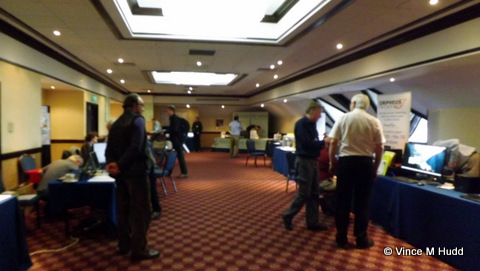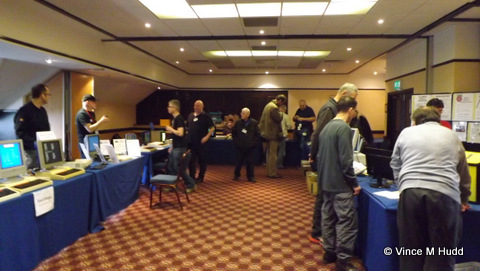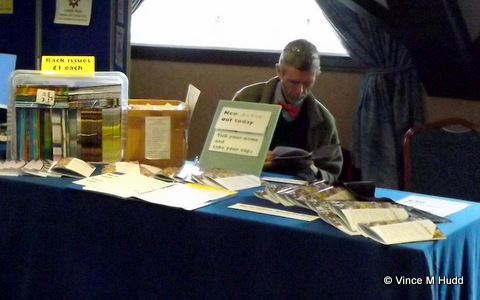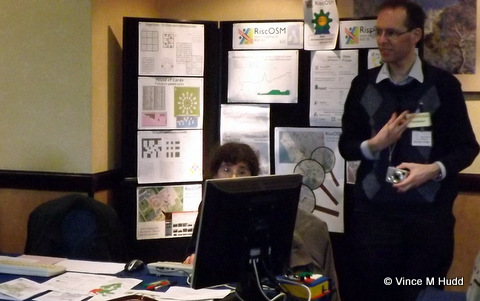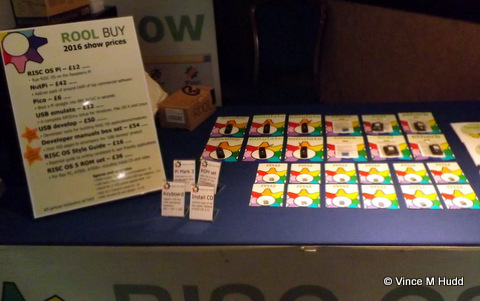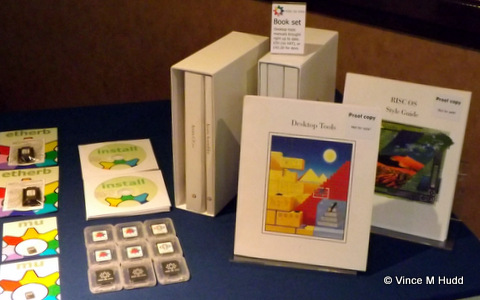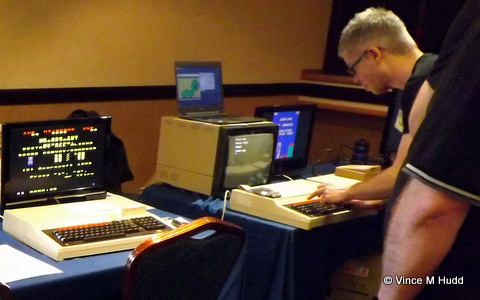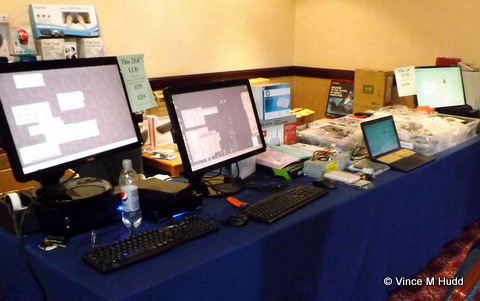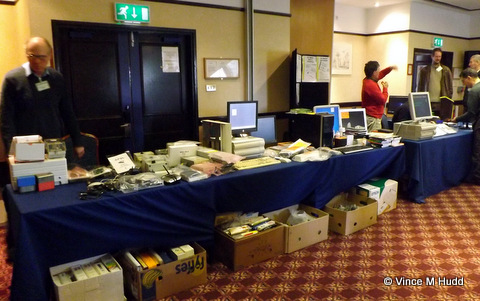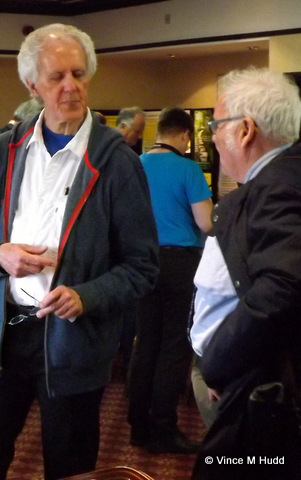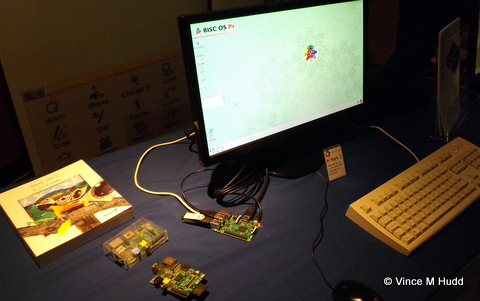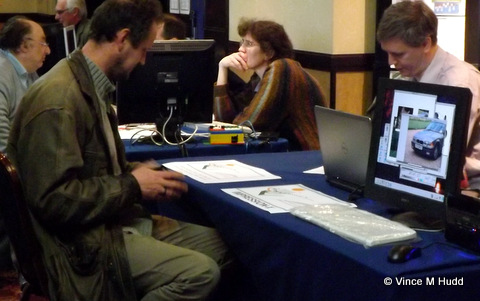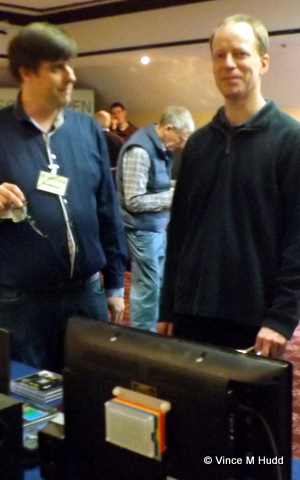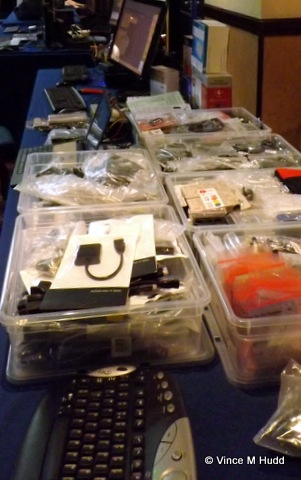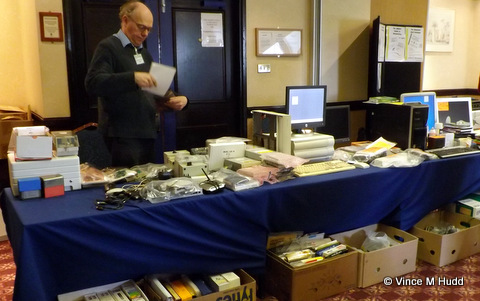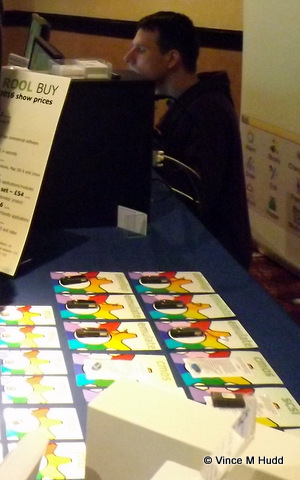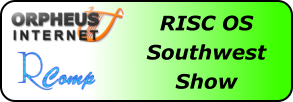Right, I’ve been up to Wakefield, had a cup of tea and a little walk, and now it’s… er, June!?
The annual trip to the North for RISC OS users – the Wakefield Acorn & RISC OS Computer Show – took place this year on 16th April, at the Cedar Court Hotel, Denby Dale, near Wakefield – the venue at which it originally started in 1996 before setting off for pastures new, and to where it returned some years ago and has remained ever since.
As is now customary, the smaller room of the two in which the main event takes place, the Hawthorn and Oak Suites, was the Retro Room, being largely occupied by the 8-bit and retro contingent. The larger Cypress Suite was therefore the RISC OS Room.
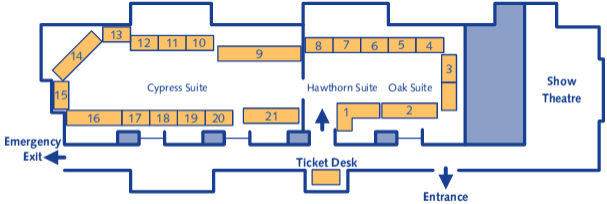
As the floor plan above shows, the entrance to the main show is in the Retro Room, so that’s where this show report will kick off – confounding all logic by starting at stand 8, and working clockwise direction to stand 1, then moving to stand 21 in the RISC OS Room, and continuing clockwise until we reach stand 9.
Daniel Jameson
Daniel was demonstrating an Econet network, with a selection of BBC computers connected up allowing visitors to load and play a wide range of games.
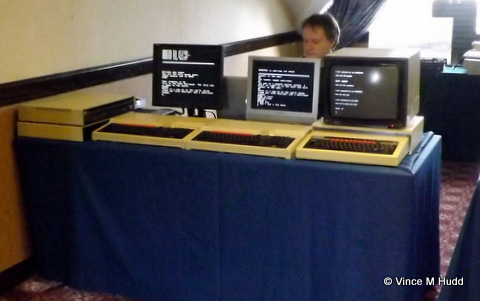
The software was loaded from an SJ Research MDFS server, which was apparently considered the best Econet file server available, due to how reliable it was and the facilities it offered, with support for multiple SCSI hard drives and the ability to drive multiple printers.
Flax Cottage
Next to Daniel was the Flax Cottage Educational Archive, John Dale’s project to collect and archive educational software. The Econet shenanigans continued on this stand, this time with a level 4 file server (running on an A3020) serving the archive to the other computers on the network – one of which was an A310 running Arthur.
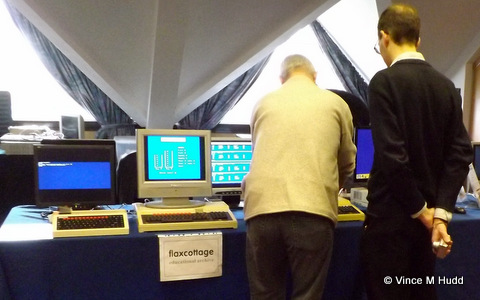
Looking at the picture above, you could be forgiven for thinking the computer at the far left is a BBC Micro, but if you’re observant you’ll realise it can’t be – by looking at the Master sitting alongside it, it’s plainly too small. It’s actually the special edition version of a case called TheFUZE, housing a Raspberry Pi (in this case a B+) – and which is normally pushed with a Linux-based dialect of BASIC called FUZE BASIC, though here it was running RISC OS.
More specifically, it was running a simple BBC BASIC program to demonstrate controlling a set of ‘traffic light’ LEDs and a 7-seg counter display, both mounted on a breadboard.
Obscured by John himself in the picture, who was explaining it to Matthew Phillips, a Raspberry Pi running RISC OS Pico (RISC OS Open’s commemorative BBC BASIC release) was connected to a BBC Master and acting as a file server for it – receiving and acting on commands sent from the Master, and returning the results of those commands.
For a lot more information, and to see the TheFUZE up close, and the breadboard mounted traffic lights in action, you could do worse than watch this video on YouTube:
It’s the third of three recorded by James West at the show, and the first eight minutes (roughly) is spent talking to John.
Retro Hardware
The smallest 8-bit stand was home to Retro Hardware, where Dave Hitchins had brought along an Acorn Electron fitted out with an Advanced Plus 6 expansion, to which a variety of other add-ons were attached, including an extra 64KB RAM which is seen by the system as shadow RAM that can be ‘paged in’ when needed, a floppy drive interface, and more.
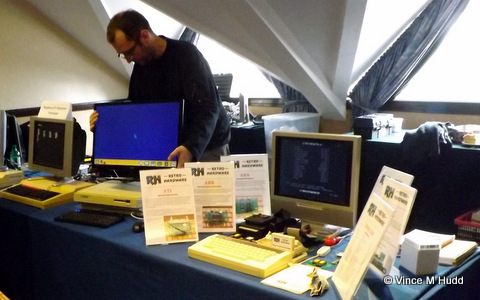
ABug
ABug is the Acorn and BBC User Group, which lacks a website but seems to operate via the Stairway to Hell forums, organising meetings for those interested in retro hardware and software – with meetings coming up in Halifax in June, and Cambridge in August.
The stand itself featured a BBC Model B and a Master, on which a number of games were available to play.
Retro Software
With a range of 8-bit games to play, Jason Nicholls was next on the Retro Software stand – where there were arcade conversions by Tricky, Electron titles by David Boddie, and games by Jason himself, including an early work-in-progress demo of a game for the BBC Master which is to be called Tequila Worm, in which the player controls the titular worm, navigating a path, drinking tequilas and snacking on chilis – both of which will affect the worm’s abilities in different ways.
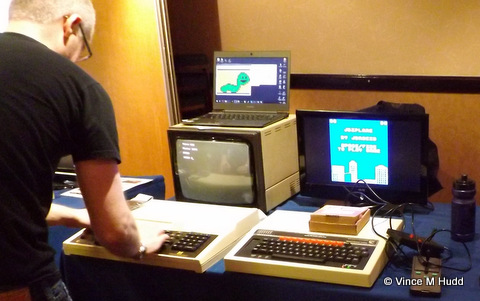
For a detailed explanation of how Jason is going about developing the game, and why it’s intended for the Master only, and not the older Model B, check out the first of James West’s three videos from the show:
John is chatting with Jason about the game in the second half of the video, while in the first half he is speaking with…
Alex Wilson
Alex – a recent returnee to the Acorn 8-bit scene – was at the end of the Retro Room, where he was showing off a BBC Master with an 80186 second processor, running GEM (a graphical user interface) on Digital Research’s DOS+, along with an Acorn Electron, with a selection of add-ons.
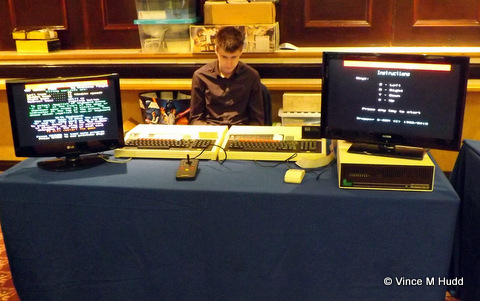
Charity stand
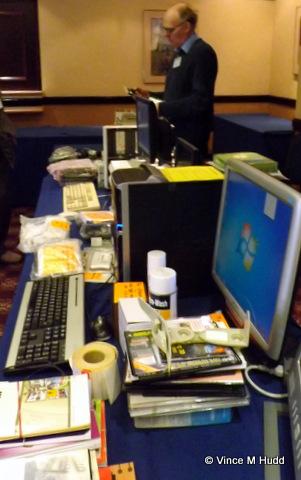
The penultimate stand in the Retro Room was the one from which, as ever, a wide selection of hardware, software, books and publications could be bought, with the proceeds going to a good cause.
The charity supported at the Wakefield Show (and by the group in general) is the Wakefield Hospice, which provides care for people with advanced, life threatening illnesses.
To date the charity stand has raised well over £17,000 (with the overall total from WROCC having topped £20,000 back in 2014). At this year’s show, those totals were increased by £764.85 – another impressive amount.
Wakefield RISC OS Computer Club
The last stand in this room was occupied by the Wakefield RISC OS Computer Club – the show’s organisers. WROCC started out in the 8-bit era, back in 1983, as the Wakefield BBC Micro User Group, but as its current name suggests it eventually expanded from the 8 to the 32-bit platform.
The group – who says they have international members stretching as far as Italy in one direction, and Canada in another – were trying to encourage visitors to join up, and selling newsletter CDs and networking guides.
Tickets were also on sale for a prize draw, and the winner of a Raspberry Pi model 3 and an official Pi case was a Mr Steve Bass – so well done to him.
MW Software
Crossing the threshold into the RISC OS Room, Martin Würthner had the next stand. Martin has been working on a new version of Artworks – version 2.X3 – though it was not quite ready for the show. Remarkably, it seems it has been some four years since the last new version of Artworks, as Martin explained during his theatre talk:
The main motivation for the new version – other than the age of the last one – is to make the software support the graphics requirements of the IGEPv5 and Titanium platforms, whereby the colours are stored in a different way to other hardware that runs RISC OS (BGR versus RGB). However, there are other new features as well, such as a new freehand shape drawing (and erasing) facility – similar to the existing freehand tool, but for shapes.
North One Communications
If you weren’t able to attend the show due to a diary clash – perhaps you had something else arranged for the same day – then North One Communications had the product for you, so that you can organise your schedule better . Except that you weren’t there to buy it because of your badly organised schedule.
Oh well.
That product, of course, is Organiser, the – no THE – personal information manager for RISC OS, and Cut-Me-Own-Throat Dibbler Nigel Willmott, along with Martin Avison who is responsible for developing the software, was selling the latest ‘Rat Organizer-on-a-stick’ edition, with version 2.24 of the software set up to run in RPCEmu 8.14 on a USB memory stick.
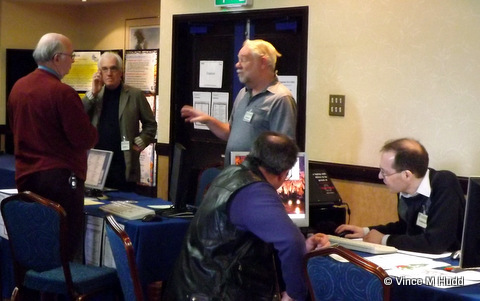
Following the show I’ve wondered if rat-shaped flash drives can be had anywhere – and the closest I’ve found are mouse-shaped, such as this leather one (which, I have to be honest, I think looks more like a frog). This example, however, I think would pass. Go on Nigel, be brave and pander to the RISCOSitory ‘humour mill’.
Sine Nomine Software
Back again to show off their range of products, Matthew and Hilary Phillips of Sine Nomine Software were next, with new versions of both RiscOSM, their OpenStreetMap-based vector mapping software, and ImpEmail, their email mail-merge package – and in both cases, one of the new features involves importing CSV files.

RiscOSM’s CSV support means that it’s now possible to load a series of items, perhaps addresses or grid references, along with other information, into the map. When initially loaded into RiscOSM, the CSV is presented in a nearly laid out window which allows you to control what fields are loaded into the software, and in what way – whether it is used to identify the location or as part of the item’s description, for example.
With ImpEmail, the CSV is – as you might expect – another source that can be used for mail-merge data, with each line in the file containing the records to fill in the necessary parts of the emails. A “Test” button allows the emails to be previewed, and any one of them can be modified without the source CSV file being changed.
Matthew gave one of the day’s theatre talks, in which he demonstrated these features and more:
Unfortunately, my usual policy of setting up the camera and leaving it running didn’t quite work out; the memory card didn’t have enough space, so my recording is missing the last few minutes of Matthew’s talk. However, Ruth Gunstone also recorded Matthew, though her video is missing the first few minutes:
Impression-X
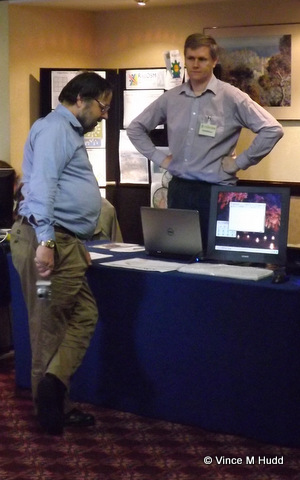
Keith Richard Keefe had the next stand, where he was showing off the latest version of Impression-X (website still to come) – the ongoing 32-bit conversion of Desktop Publishing software Impression, which in its 26-bit form was originally from Computer Concepts.
The software still has a very long way to go before it no longer needs Aemulor to run on modern hardware, though it is – slowly – getting there. Richard told me that the next new version – his fourth release of the software, and the first release of the ‘second phase’ (with each phase covering three releases) – was imminent, which incorporates the changes that went into Publisher Plus 5.13, along with some general bug fixes.
AmCoG Games
With another new game under his belt, Tony Bartram of AmCoG Games was next.
That new game is Xeroid, a game inspired by the Clares Micro Supplies classic, Fervour, and the objective is to guide a craft along a highway in space – but not a hyperspace bypass, so no Earths were demolished to make way for it, and Tony isn’t a Vogon anyway. Along the way there are obstacles to overcome, such as gaps in the highway or different coloured sections which will affect your craft in different ways, with the aim being to safely reach the end.
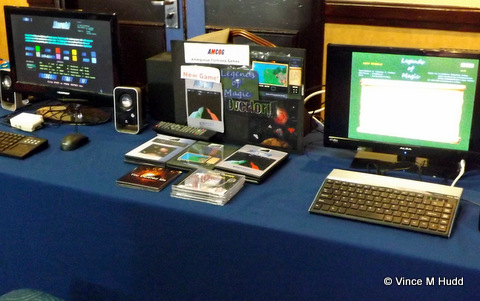
Tony is working on updates to the game, including compatibility for VirtualAcorn products, as well as additional levels and general improvements, so expect a new, improved version sometime hopefully soon.
If you haven’t seen Xeroid running, then the second of James West’s videos is worth a look; here James is talking to Tony, who is demonstrating the game at the start:
The previous AmCoG games are also demonstrated in this video, Legends of Magic quite briefly – both the original version and the Treasure Quest expansion – and Overlord, which gets a little more screen time.
Tony also briefly talked about the iDent Micro / One that he’s using. Visitors to the recent Midlands User Group meeting will have seen this discussed by its designer, Tom Williamson, and it’s looking as though Tom may be attending the London Show in October, so there’s a good chance that visitors to that show will be able to find out more about it.
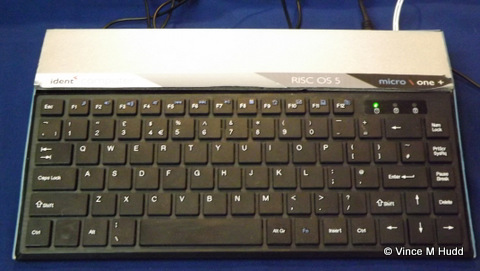
CJE Micro’s and 4D
Saving the day for me with an emergency SD card (for the theatre talk videos) and an emergency cable so that I could actually use the computer I’d brought with me – thanks guys – Chris Evans and Andrew Conroy of CJE Micro’s had once again brought a wide range of both RISC OS-specific and generic IT related paraphernalia – ranging from smaller items, such as my two emergency purchases, all the way up to computer systems, in the form of their RapidO Ig and Ti machines.
One of the show’s theatre talks was given by Chris, who as usual shunned the use of the projector, opting instead to hold things up for the audience to see – although expectations may have been raised by the RISC OS desktop appearing on the screen behind him very early into the talk.
As well as giving a general overview of some of the products they had available, and where they might be useful, Chris went into a brief rundown of both the similarities and the differences of the RapidO Ig and Ti computers – with the former being based around an IGEPv5 board, and the latter a Titanium.
Steve Fryatt
With a show record so far this year of 100% – he’s attended both the Southwest and Wakefield shows – Steve Fryatt was next, where a CD was available to buy with the latest versions of his software, including PrintPDF and CashBook, the grumpy home accounts package.
RISC OS Open Ltd
ROOL Corner could be found in its regular spot in the far corner of the RISC OS Room, a spot so named because for the last several years it has been consistently occupied by RISC OS Open Ltd – which this year was ably represented by Ben Avison and Rob Sprowson.
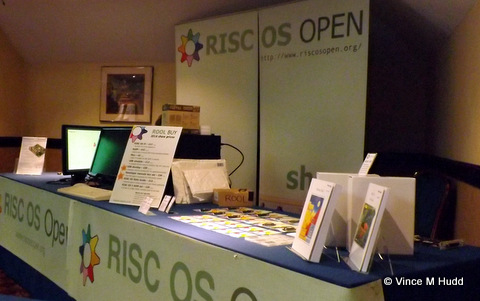
Goodies on offer from ROOL included the usual range; RISC OS Pi, NutPi, and Pico SD cards, the ’emulate’ and ‘develop’ flash drives, as well as the new manuals that have been brought out over the last year or so.
Goodies on display included a Titanium-based system, and a Raspberry Pi 3 – the latest addition to the Pi range, which was launched at the end of February, just a few days after the Southwest Show.
Rob gave the RISC OS Open theatre presentation, of which there are two alternative videos to watch. The first is RISCOSitory’s own:
And the second was recorded by Ruth Gunstone of the Wakefield group:
The talk covered everything RISC OS Open had done since the last Wakefield Show, starting with an updated NutPi collection being released. Sales of the card, which provides a way to get a wide range of commercial software to run on the Pi under RISC OS for a comparatively small outlay, have apparently resulted in some £20,000 being dispersed amongst those whose software is included.
Running all the way through the year, eventually the timeline reached the day before the show – which marked the completion of the JPEG bounty. This means that once the resulting code is released (keep your eyes peeled on RISCOSitory for more news), RISC OS will be able to open and display a wider range of JPEGs than before.
Drag ‘n Drop
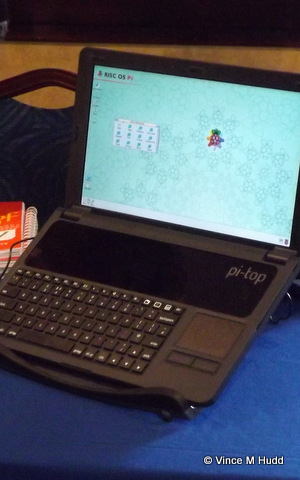
For those in the market for some reading material, the next stand was home to on-off-on-off-under-new-management PDF magazine Drag ‘n Drop. At least, it was for half the day, anyway, because editor Chris Dewhurst’s appearance at the show was scheduled to start at midday.
As well as selling his ‘Book of Draw Stuff’ and flash drives containing every issue of Drag ‘n Drop, from the very first to the very latest, Chris had also brought along a Pi-Top for visitors to see.
The Pi-Top is a Raspberry Pi in a laptop-style case – and, of course, Chris was running RISC OS on it.
Soft Rock Software
In my Soft Rock Software role, I was next – and I had the latest RiscPiC-mini cases available to buy, as well as the latest standard RiscPiC case available to look at and see why it wasn’t quite ready again.
Since the last show, I have also commenced work on a new version of the first of Soft Rock’s old budget games – Escape from Exeria – although that work, so far, has only been to design new, higher resolution graphics. There wasn’t a playable version, therefore, only a graphics file with which I was explaining how I expected some of the animations to work.
Archive Magazine
Volume 24, issue 1 – a brand new, 56 page issue – of Archive Magazine was available from the next stand. An updated CD/DVD, with the most recently completed volume added to its contents, is planned but may not be ready for a while.
Undertaking a charity bike ride last year, this year saw the return of the magazine’s original editor, Paul Beverley, who regularly attends the Wakefield Show to assist current editor, Jim Nagel.
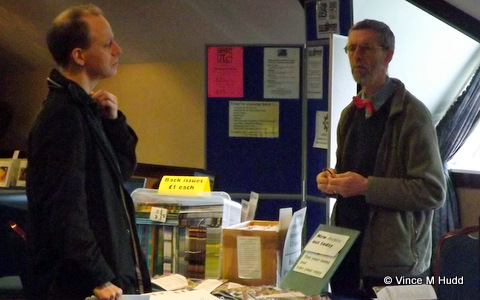
Paul pointed out to me during the show that next year, 2017, marks the 30th anniversary of the original Archimedes being launched – which was in June 1987. I wonder if anyone has told Richard Brown?
Orpheus Internet
Richard, of course, was on the penultimate stand of the show, wearing his Orpheus Internet hat. Running the RISC OS friendly ISP that was founded by the late Paul Vigay, Richard was discussing any and all internet access, web hosting and domain requirements, along with remote service contracts, and a hosted backup service.
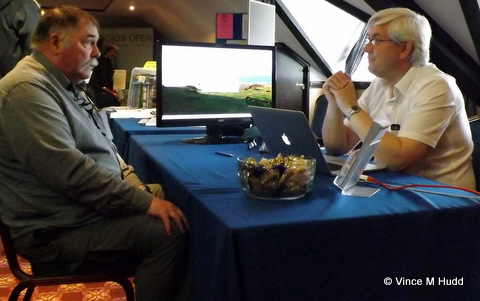
While Richard has had good reason to bring cakes to RISC OS shows for the last couple of years, this year lacked any significant anniversaries, so it was back to the bowl of sweets.
So, yes, someone did tell Richard that it was the Archimedes’ 30th birthday next year – I made him aware of it as soon as Paul Beverley mentioned it to me!
R-Comp and R-Comp Interactive
After Richard, the final stand belonged to R-Comp and R-Comp Interactive, with a range of hardware and software on offer.
Hardware, of course, included the ARMX6, a now proven and well liked machine, as well as the new Titanium-based TiMachine. Software included a brand new update of Doom featuring MP3 music in place of the older MIDI-style tunes, the newly released Fireworkz Pro 2, and a new version of DP Genealogy.
In his theatre talk, Andrew discussed the new Titanium platform, which has brought about an unusual (for R-Comp) situation in that, so far, each new ARM-based platform has replaced the previous one to become the current, primary platform – but not with the Titanium-based TiMachine; with it and ARMX6 both offering differing areas of strength, the two are in effect concurrent.
He also then demonstrated a number of things – including, briefly, the new version of Doom – and even the recording(s) of the talk show just how good the MP3 audio is.
RISCOSitory’s recording of Andrew’s talk is here:
And Ruth Gunstone’s is here:
And with that, we have completed the circuit of both the Retro and RISC OS Rooms and, therefore, the whole show.
Speaking as an exhibitor, I found I was reasonably busy for most of the day – but Chris Hughes of WROCC informs me that visitor numbers were slightly down on last year, which is a shame, but perhaps not surprising, for two (closely related) reasons.
Firstly, while there were new versions of various pieces of software, and plenty of interesting things to see and talk about, there were no exciting new releases, no rumours in the run up to the show to cause a buzz – although I’m sure that for every developer that had brought along a new version of this, or an updated version of that, their own products were very exciting!
Secondly, and almost certainly part of the reason for the above, is the timing. Since 2008, when the Wakefield Show moved from May into April, the gap each year between the Southwest and Wakefield Shows – the period in which regular exhibitors must recover from the first, and start working on things for second – has always been fairly short. This year, however, was only its second shortest, at just seven weeks. The record shortest was 2011, with a gap of just six weeks between the Southwest Show on 5th March, and the Wakefield Show on – again – 16th April, and the normal gap tends to be eight or nine weeks, with the latter having been the case most.
We already have a date for next year’s Southwest Show: Saturday, 25th February. So when might Wakefield 2017 fall?
Easter 2017 falls on Sunday, 16th April, which probably rules out Saturday, 15th. The 29th is also probably out of the picture, because that’s the early May bank holiday weekend (Monday is 1st May). To keep the show in the latter half of the month, then, means 22nd April – and that would mean an eight week gap, which is still short (and matches 2013 and 2014) but better than this year and 2011.
Meanwhile, we are now in the much longer gap between Wakefield and the next show (if you don’t count Recursion, which is a much bigger event featuring much more than just RISC OS, and which takes place in four weeks time) – the London Show takes place on 29th October, some twenty weeks to go (and twenty seven weeks – just over half a year – after Wakefield). I’ll see you there!
Meanwhile, as well as the pictures and videos above, you can also find a few photos on the Wakefield 2016 thread on the Stairway to Hell forum, along with details of the event from the point of view of the retro contingent. A selection can also be found on Ian Wolstenholme’s Beebmaster website, and there are some on Chris Hall’s website along with summaries of what was said in most of the theatre talks.
And the rest of the just about usable photos of my own are below.
